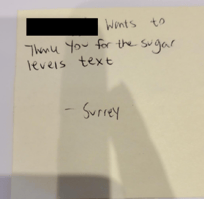
Today, I am pleased to announce Azara’s partnership with CareMessage, a patient engagement platform that like Azara DRVS, focuses on the needs of health centers and other safety-net providers. I first met Care Message’s CEO, Vineet Singal almost five years ago. We connected almost immediately on a variety of things including our growing early stage companies and our companies’ passions around supporting those providing healthcare to our country’s most vulnerable. I was also enamored with adding patient outreach capabilities to DRVS and I did not need to be convinced of the efficacy of texting. I already knew that DRVS helps our clients by producing accurate contact lists for specific programs such as who is due for a well child visit or a cancer screening and I was certain texting worked better than any of the alternatives for volume patient outreach, primarily letters and robocalls.
One of the things we discussed back in 2015, and for sometime thereafter, was the best way for our companies to engage to support our clients. After all, we were both relatively small entities with the desire to focus on meeting the immediate needs of our respective clients and while we both thought a partnership would be valuable to those same clients, it was hard to justify the upfront investment for this specific partnership. This kept pushing our ability to act on a product integration down the road and we each continued to search for the “right” opportunity to bring us together.
Last fall, we found that opportunity within a few mutual clients. Both companies made the necessary investments and we conducted two integration pilots. Subsequently, we have conducted joint patient outreach programs from DRVS through CareMessage for more than 20 Azara clients with great results. I am excited about the possibilities this partnership presents and happy that both parties persevered to reach today. Azara’s analytics team has quarterbacked our initial efforts and I will let Phil Parker, our Vice President of Client Analytics describe some of the process.
> Read the Success Story
> Read the Press Release
___________
Philip Parker
Vice President, Client Analytics
 Integrating DRVS and CareMessage has been one of the most exciting and rewarding projects of my career to date. We consistently hear that DRVS empowers our customers to provide higher quality care to patients, but because our role is behind the scenes, it can be hard to feel directly connected to the outcomes. Outreach via CareMessage gives us the opportunity to view firsthand, the direct connection with patients as they engage and optimize their own healthcare. The most gratifying part is knowing patients appreciate the messages they receive. I look at the response message logs often, and the number of “Thanks!!” or “Cool!” responses we see come back is very uplifting. Some patients have even called their health center just to thank them for sending the message.
Integrating DRVS and CareMessage has been one of the most exciting and rewarding projects of my career to date. We consistently hear that DRVS empowers our customers to provide higher quality care to patients, but because our role is behind the scenes, it can be hard to feel directly connected to the outcomes. Outreach via CareMessage gives us the opportunity to view firsthand, the direct connection with patients as they engage and optimize their own healthcare. The most gratifying part is knowing patients appreciate the messages they receive. I look at the response message logs often, and the number of “Thanks!!” or “Cool!” responses we see come back is very uplifting. Some patients have even called their health center just to thank them for sending the message.
One of Azara’s core values has always been to meet our customer (FQHCs) where they are, and not approach projects with assumptions from the ivory tower. We are well aware that FQHC staff are already overburdened as it is, and managing and coordinating a robust messaging program could quickly become a full-time job or yet another area that many FQHCs are generally not properly staffed to handle. The CareMessage platform makes it easy to outreach to large groups of patients once identified, but while doing all of that identification to find the right population and moving those patient lists from DRVS into CareMessage is relatively easy, it can be very time consuming.
When discussing the pilot project with a lead user, we were looking at the diabetes registry in DRVS and they asked, “Can you just look at this registry every week and text the people who need an A1c?” This question spurred the creation of the ongoing automated campaigns. Once configured, our “Set it and Forget it” campaigns automatically text patients that newly qualify for a campaign. For example, if a patient is newly diagnosed with diabetes, we will automatically enroll them in the appropriate diabetes campaign and begin messaging them, without anyone at the center having to lift a finger. Once the patient performs the desired action (making an appointment or getting an A1c), we will stop texting them, or they may receive a text about a different campaign the center is running.
Another part of meeting FQHCs where they are is supporting and enhancing existing operations rather than requiring new workflows and large-scale process changes. We have had to learn a great deal about areas of health center operations that we’ve previously not studied to achieve these goals. Particularly, we took a deep dive into call center operations. Our early pilot centers were concerned about creating a flood of incoming calls if all members of a text campaign simultaneously were asked to schedule an appointment. It would be a pretty poor experience (and a waste of effort) for the patient to receive a text, make the decision to call the center, and then be placed on hold for a long time or have the call go through to voicemail. Responding to this, we designed our system to spread the messages out over the hours the call center is open, generating a steady and manageable stream of calls.
 I could go on for pages about all of the different interesting bits and pieces of our product and how they came about, and I definitely will elaborate in future blog posts. I will also share the results of these pilots, some of which are quite impressive. However, for now I can tell you that the response from patients is real, and it doesn’t require an advanced degree in statistics to see it. Sometimes, it is just a simple message from a patient who called to thank the center for messaging them.
I could go on for pages about all of the different interesting bits and pieces of our product and how they came about, and I definitely will elaborate in future blog posts. I will also share the results of these pilots, some of which are quite impressive. However, for now I can tell you that the response from patients is real, and it doesn’t require an advanced degree in statistics to see it. Sometimes, it is just a simple message from a patient who called to thank the center for messaging them.
